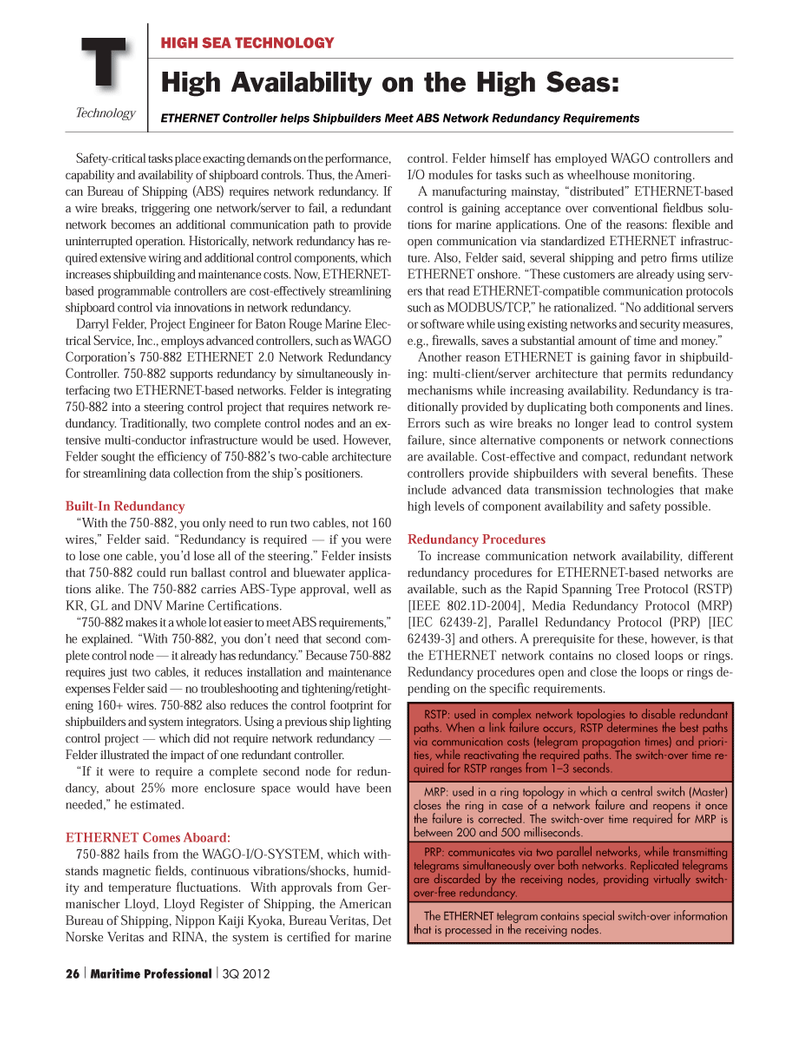
Page 26: of Maritime Logistics Professional Magazine (Q3 2012)
Classification Societies, Quality & Design
Read this page in Pdf, Flash or Html5 edition of Q3 2012 Maritime Logistics Professional Magazine
Technology HIGH SEA TECHNOLOGY High Availability on the High Seas: ETHERNET Controller helps Shipbuilders Meet ABS Network Redundancy Requirements TSafety-critical tasks place exacting demands on the performance, capability and availability of shipboard controls. Thus, the Ameri- can Bureau of Shipping (ABS) requires network redundancy. If a wire breaks, triggering one network/server to fail, a redundant network becomes an additional communication path to provide uninterrupted operation. Historically, network redundancy has re- quired extensive wiring and additional control components, which increases shipbuilding and maintenance costs. Now, ETHERNET- based programmable controllers are cost-effectively streamlining shipboard control via innovations in network redundancy. Darryl Felder, Project Engineer for Baton Rouge Marine Elec- trical Service, Inc., employs advanced controllers, such as WAGO Corporation?s 750-882 ETHERNET 2.0 Network Redundancy Controller. 750-882 supports redundancy by simultaneously in- terfacing two ETHERNET-based networks. Felder is integrating 750-882 into a steering control project that requires network re- dundancy. Traditionally, two complete control nodes and an ex- tensive multi-conductor infrastructure would be used. However, Felder sought the ef ciency of 750-882?s two-cable architecture for streamlining data collection from the ship?s positioners. Built-In Redundancy?With the 750-882, you only need to run two cables, not 160 wires,? Felder said. ?Redundancy is required ? if you were to lose one cable, you?d lose all of the steering.? Felder insists that 750-882 could run ballast control and bluewater applica- tions alike. The 750-882 carries ABS-Type approval, well as KR, GL and DNV Marine Certi cations.?750-882 makes it a whole lot easier to meet ABS requirements,? he explained. ?With 750-882, you don?t need that second com- plete control node ? it already has redundancy.? Because 750-882 requires just two cables, it reduces installation and maintenance expenses Felder said ? no troubleshooting and tightening/retight- ening 160+ wires. 750-882 also reduces the control footprint for shipbuilders and system integrators. Using a previous ship lighting control project ? which did not require network redundancy ? Felder illustrated the impact of one redundant controller. ?If it were to require a complete second node for redun-dancy, about 25% more enclosure space would have been needed,? he estimated. ETHERNET Comes Aboard: 750-882 hails from the WAGO-I/O-SYSTEM, which with- stands magnetic elds, continuous vibrations/shocks, humid-ity and temperature uctuations. With approvals from Ger- manischer Lloyd, Lloyd Register of Shipping, the American Bureau of Shipping, Nippon Kaiji Kyoka, Bureau Veritas, Det Norske Veritas and RINA, the system is certi ed for marine control. Felder himself has employed WAGO controllers and I/O modules for tasks such as wheelhouse monitoring. A manufacturing mainstay, ?distributed? ETHERNET-based control is gaining acceptance over conventional eldbus solu- tions for marine applications. One of the reasons: exible and open communication via standardized ETHERNET infrastruc-ture. Also, Felder said, several shipping and petro rms utilize ETHERNET onshore. ?These customers are already using serv-ers that read ETHERNET-compatible communication protocols such as MODBUS/TCP,? he rationalized. ?No additional servers or software while using existing networks and security measures, e.g., rewalls, saves a substantial amount of time and money.? Another reason ETHERNET is gaining favor in shipbuild- ing: multi-client/server architecture that permits redundancy mechanisms while increasing availability. Redundancy is tra- ditionally provided by duplicating both components and lines. Errors such as wire breaks no longer lead to control system failure, since alternative components or network connections are available. Cost-effective and compact, redundant network controllers provide shipbuilders with several bene ts. These include advanced data transmission technologies that make high levels of component availability and safety possible. Redundancy Procedures To increase communication network availability, different redundancy procedures for ETHERNET-based networks are available, such as the Rapid Spanning Tree Protocol (RSTP) [IEEE 802.1D-2004], Media Redundancy Protocol (MRP) [IEC 62439-2], Parallel Redundancy Protocol (PRP) [IEC 62439-3] and others. A prerequisite for these, however, is that the ETHERNET network contains no closed loops or rings. Redundancy procedures open and close the loops or rings de- pending on the speci c requirements. RSTP: used in complex network topologies to disable redundant paths. When a link failure occurs, RSTP determines the best paths via communication costs (telegram propagation times) and priori-ties, while reactivating the required paths. The switch-over time re-quired for RSTP ranges from 1?3 seconds. MRP: used in a ring topology in which a central switch (Master) closes the ring in case of a network failure and reopens it once the failure is corrected. The switch-over time required for MRP is between 200 and 500 milliseconds. PRP: communicates via two parallel networks, while transmitting telegrams simultaneously over both networks. Replicated telegrams are discarded by the receiving nodes, providing virtually switch- over-free redundancy. The ETHERNET telegram contains special switch-over information that is processed in the receiving nodes.26 | Maritime Professional | 3Q 2012

 25
25

 27
27
